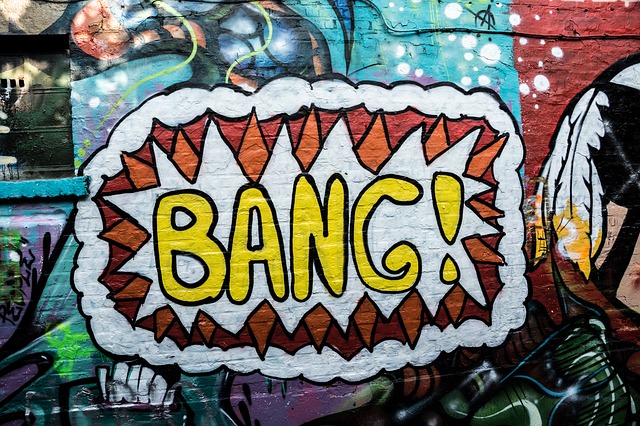
I remember the first time I learned about onomatopoeia. There was a popular commercial of a little girl spelling the word in a spelling bee, so it was already on my radar. Not long after, my elementary teacher explained this literary device.
“It’s a word that describes a sound, like crash and bang.” We didn’t get much deeper than this cursory explanation, but the young writer in me fell in love with this funny word.
As I got older, I learned more about the exciting world of literary devices. There were anaphora and parallelism, litotes and hyperbole, assonance and consonance. My senior English teacher gave us a four-page list of literary devices to memorize and learn to identify. There wasn’t a lot of focus on onomatopoeia, but I eventually learned that onomatopoeia is more nuanced than a comic book-style interjection.
I soon learned that a lot of writers—and readers—hate it. I have a sentence in an early chapter of my second book, The Consort’s Journey, that describes the “clip-clopping of the horses’ hooves.” When I presented this chapter to my critique group before publication, five of the six writers commented on how much they liked that phrasing. One was almost angry as he argued with everyone else. He said it was cheesy and amateur.
If you spend time searching through writing and literature forums, you’ll find that the use of onomatopoeia is a contentious subject. My colleague was not alone in his opinions of onomatopoeia. The overall consensus is that it’s okay to use sparingly, but there’s not a lot of discussion on how to use it effectively.
Understanding Onomatopoeia
My third-grade teacher was right. Onomatopoeia is a word that describes a sound. In many cases, its only meaning is to describe a sound, like kapow!
The most easily identifiable examples of onomatopoeia are in comic books. The panels describe sounds through bubbles with words like crash, bang, pow, and zap. In other forms of fiction, these words often appear as standalone sentences or interjections.
- Crash! I jumped at the noise and looked up to see my cat staring guiltily at a broken vase on the floor.
- I was walking to work when—bang!—a piano dropped out of a window directly in front of me.
But onomatopoeia includes plenty of other words. It’s any word that sounds like the word it describes. A hum is a low, close-mouthed noise, and it sounds a lot like the word hum. If you tell your kid not to splash in the bathtub, you’re describing not only the action of splashing but also the noise water makes when you splash.
You have probably used onomatopoeia in your writing without even realizing it. Maybe there’s a creaking door or a sizzling sausage on the skillet. Onomatopoeia can be a powerful literary device when used effectively. It falls under the important skills of word choice and showing versus telling.

Problems with Onomatopoeia
Before we discuss the right ways to use onomatopoeia, let’s talk about some of the problems with this tool. One of the main issues is the overuse of onomatopoeia. We want to include the five senses when we describe scenes. We want our readers to not only see our stories, but to use their sense of smell, taste, sound, and touch in their imaginations to fully experience the world we have built for them. Onomatopoeia is an effective way to include the sense of sound.
The overuse of onomatopoeia typically comes from too many interjections or one-word sentences. These can affect the pacing of your writing and jolt your reader out of the story. Repetition can quickly become cliché.
Word choice is another issue with onomatopoeia. The words you use to describe sound should match the tone, target age group, and genre of your book. Often, onomatopoeia interjections are used more commonly in middle-grade and young adult fiction. The diction must be simpler and easier to read for younger readers who don’t have an advanced vocabulary.
Onomatopoeia is by no means meant only for young audiences, but be mindful that the word you choose matches the tone of your writing. A plop is a great descriptor for comedic writing or contemporary, informal scenes. Plops of water do not, however, fit in a dramatic scene in a Medieval-inspired fantasy world.
Effective Use of Onomatopoeia
So, we know what to avoid doing. But how can we use this tool to make our descriptions more powerful?
Choose sound words to flow in your sentences. Onomatopoetic words can be used as verbs, nouns, and even adjectives. Using these words is far more effective than just sprinkling in interjections. It won’t pull your reader out of the story because it’s part of the overall flow of your descriptions.
Verbs as Onomatopoeia
Description isn’t just about adjectives. Choosing powerful, active verbs is the best way to show instead of tell. They allow the reader to fully experience a scene and help set the tone. They also add specificity to your writing.
Let’s look at some examples of onomatopoetic verbs:
- He flipped a switch, and the furnace roared to life.
- The cabinet doors were opened, revealing forgotten plates and chipped mugs. Trash overflowed from the garbage can, and flies buzzed around it. Water dripped from the faucet into the dirty sink.
- She gasped as she looked out the window. He was home.
- He hissed at me to get away from him. I took a step back. He was trembling, and he panted in pain. Fear shone from his bruised eyes, and blood dribbled from the corner of his mouth.

Let’s take a look at the same scenes without onomatopoeia:
- He flipped a switch, and the furnace turned on.
- The cabinet doors were opened, revealing forgotten plates and chipped mugs. Trash overflowed from the garbage can, and flies circled around it. Water fell from the faucet into the dirty sink.
- She took a deep breath as she looked out the window. He was home.
- He told me to get away from him. He was trembling, and he was breathing in pain. There was fear in his bruised eyes and blood on the corner of his mouth.
The onomatopoeia examples give us a much clearer picture of each of these scenes. In the second set of examples, we can’t hear what’s going on. We don’t understand the situation as clearly as before. Was it a small, quiet furnace or a large, loud one? Was the water gushing or dripping from the faucet? How did she feel when she saw he was home? Is the blood fresh or an old wound?
Nouns as Onomatopoeia
Verbs aren’t the only words we can use for sounds. There are plenty of onomatopoetic words that can be used as nouns. Again, these add a degree of realness and specificity to your descriptions.
Here are some examples:
- A crash sounded from the opposite room, followed by scrapes and clangs.
- He jumped into the water after me with a splash and a euphoric chortle.
- In December, the shops are filled with chatter and jingles and friendly greetings of “Happy Holidays.”
The alternative to these onomatopoeic nouns would be using generic words like sound and noise. But there are many different types of noise, and it can be hard for your reader to conjure the right effect for themselves. Using a precise word that echos the sound will allow your reader to hear it in their imagination.
Adjectives as Onomatopoeia
Onomatopoetic adjectives should be used sparingly, but can be highly effective:
- The middle-school teachers avoided the hallway with the cacophonous band and orchestra classes.
- The barn was full of squealing pigs and bleating sheep.
- I walked through the drizzling rain and rumbling thunder.
Use them when you want the reader to pay particular attention to the manner of the environment in your story.
Final Thoughts
Onomatopoeia doesn’t have to make your readers cringe. When used correctly and effectively, it can be a powerful literary device to enrich your story. As writers, one of our main jobs is to bring the words on the page to life for our readers. Spice up your descriptions with some tone-appropriate onomatopoeia, and make your next work hit the shelves with a bang!

